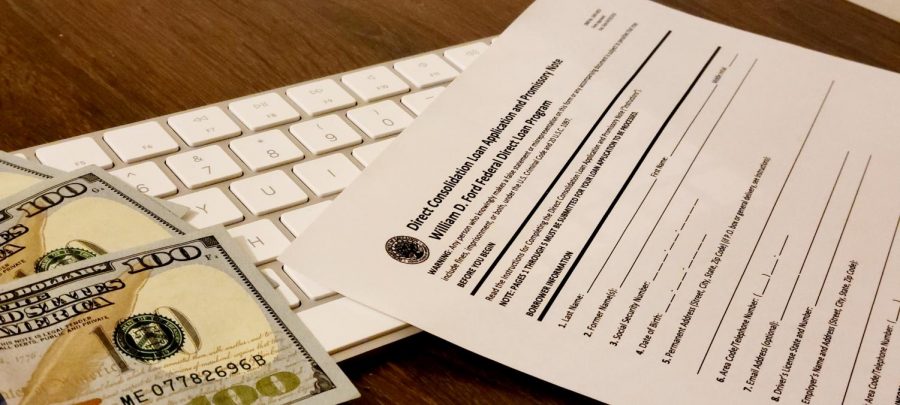Rising Tuition, Low Wages: How One Generation Bears the Cost of Student Loans
High cost of attendance pushes more students to take on loans, which adds up $1.6 billion education loans.
Just over 50 days ago, Joe Biden was sworn in as the 46th president of the United States.
Biden stated that Congress should forgive $10,000 in student debt for all borrowers. Though Mr. Biden has not endorsed the idea of cancellation of all debt that was proposed by his challengers during presidential candidacy, the Biden Administration could take action on the $1.6 trillion student loans.
Student loan has been a critical issue for many Americans struggling to pay off their debt. With the COVID-19 pandemic striking American households, a new generation is battling to find employment opportunities.
Though the federal student loan interests and payments have been put on pause by former President Donald Trump in an effort to ease the financial damages the pandemic has caused, many students had already been struggling to pay their shares.
“In Westchester and Rockland Counties, where it is extremely expensive to live, thousands of people my age must live at home with their parents or grandparents because they cannot afford to live independently paying rent or a mortgage,” U.S. Rep. Mondaire Jones of New York, whose district covers Pace University’s Westchester campuses, said in a statement.
Additionally, we should forgive a minimum of $10,000/person of federal student loans, as proposed by Senator Warren and colleagues. Young people and other student debt holders bore the brunt of the last crisis. It shouldn’t happen again.
— Joe Biden (@JoeBiden) March 22, 2020
The discussions of canceling student debt were part of the presidential debates. Since Biden’s election, many Democratic members of Congress have called on the President to partially or fully forgive student debt. Senators Chuck Schumer of New York and Elizabeth Warren of Massachusetts argued in a joint op-ed that $50,000 of those loans be canceled, which in the end would bring that money back to the communities who can use it to buy homes and start a family.
The student debt crisis hits the minorities the hardest, who tend to earn less and have to take out more loans to afford college. Black and Latinx borrowers are less likely to land on jobs that are enough to pay off their loans. In addition, minorities earn less per capita than their white peers, which results in unpaid loans.
Cancellation of student debt, whether partial or full, would help reduce the racial wealth gap. The average wealth of a white household is $983,400 while a black household earns 6.9 times less, with an average amount of $142,500.
“This is an issue of gender justice, racial justice, economic justice, and LGBTQ+ justice. Women bear two-thirds of this national student debt,” Representative Jones stated. “Disproportionately people of color and members of the LGBTQ+ community, who on average have $16,000 more in student debt, bear the brunt of this crisis.”

For a very long time, higher education was thought to provide a better future, job security, and higher wages. With school expenses increasing significantly, tuition has skyrocketed. Since the 2017-2018 academic year, tuition at Pace increased by 8.4%, from $43,986 to $47,684, according to the National Center for Education Statistics.
The high cost of attendance pushes more students to take on loans, which adds up to $1.6 billion in education loans. Pace students think that student loans are unfair. In a response to a one-question survey, 81% of Pace students stated that they support the cancellation.
Student loans have more than doubled in the last decade and tripled since 2006, with the current cost of more than $1.6 trillion. Additionally, average college tuition has increased by roughly 260% since 1980.
“This is different from the way things were a generation ago when the American Dream was less elusive,” Congressman Jones said, adding that wages are not consistently increasing while the cost of attendance skyrockets significantly. “The average debt of someone graduating from a four-year college or university today is four times higher than it was in the early 90s.”
While a $10,000 debt cut would be less of a solution, $50,000 relief could drastically decrease 93% of low-income Black households. Yet, it is not an easy task for the White House or Congress to take action on.
President Biden may sign an executive order abolishing all student debt, but this would likely be challenged at a federal court and the decision can be overturned. However, according to the Higher Education Act of 1965, Congress allows the Education Secretary to cancel federal student debt.
Describing the urgency of the student debt crisis that affects millions of Americans, Congressman Jones said “President Biden has a chance to end this crisis with the stroke of a pen by canceling $50,000 in student debt. For the sake of the 43 million Americans burdened by student debt, and for the sake of our economy, we must do so.”
Your donation supports independent, student-run journalism at Pace University. Support the Pace Chronicle to help cover publishing costs.

